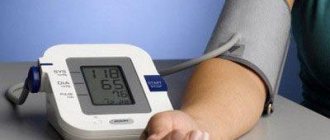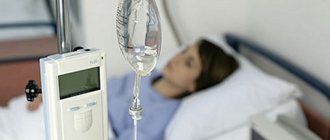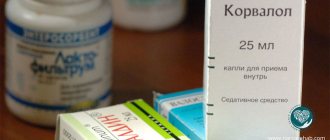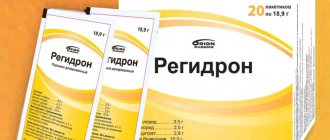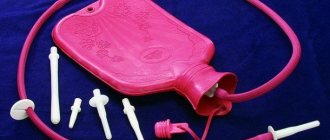A dropper for alcohol intoxication will help quickly remove toxins that have accumulated after drinking alcohol. Alcohol negatively affects a person’s well-being and the functioning of internal organs, but without it it is difficult to imagine any festive or sad event. Drinking alcohol at home or in public institutions is fraught with a number of consequences from which no one is immune.
Emergency situations for placing an IV at home
Alcohol poisoning occurs due to prolonged consumption of drinks containing ethanol. The use of a dropper depends on the person’s condition due to alcohol intoxication. Sometimes excessive alcohol consumption provokes a heart attack, and the patient experiences shortness of breath or fainting .
In such situations, the patient is immediately hospitalized, performing the procedure in a medical facility. If there are no severe complications, therapy can be performed at home.
However, it is always necessary to understand that you cannot select hangover cures on your own. You need to call a narcologist, since only he is able to organize the correct implementation of the procedure.
To remove ethanol, infusion therapy is recommended to be done in a hospital, and the process should be supervised by a qualified doctor.
This treatment is indicated in situations with severe conditions of a patient who has:
- Progression of any concomitant disease simultaneously with alcohol intoxication;
- The occurrence of complications due to ethanol abuse;
- Fainting, heart failure due to alcohol poisoning.
When there are no such indications, it is permissible to install an IV at home, although in this case it would be better if a specialist performs this procedure. It is easy to call a doctor at home in case of alcohol intoxication. This service is common and is provided by many specialized medical institutions.
The narcologist is independently able to assess the severity of the patient’s condition and make an adequate decision: whether immediate hospitalization is required or whether it is enough to get rid of alcohol at home.
When is detoxification recommended?
Freeing the body from alcohol and its breakdown products is required in various situations faced by narcologists.
They have to help with:
- acute alcohol poisoning.
We are not always talking about taking significant doses of alcohol. A person who tastes wine and vodka products in small quantities for the first time can also become poisoned. The toxic effect on it develops as a result of the low content of enzymes that break down ethanol and individual hypersensitivity to this poison; - binges of varying duration and complexity to interrupt them;
- withdrawal syndrome in people in a post-drunken state;
- the need to quickly return to work for people who have taken a significant amount of alcohol;
- one-time coding in situations where a client of a drug clinic wants to be coded immediately after cleaning (in the absence of contraindications and the consent of the doctor).
Rules for the procedure
It is forbidden to insert an IV without the necessary skills, as this will provoke undesirable consequences, and death is not excluded. It is also necessary to use the medications recommended by the doctor correctly.
Having found out from the narcologist the permissible dosages of the drug, you are allowed to carry out the procedure yourself. It must be done with sterile gloves.
The sequence of the procedure is as follows:
- Place a stand next to the patient. It can be replaced by any object that allows you to secure the container with the medicine above the patient’s head. This will allow the liquid to flow down on its own.
- Be sure to wash your hands with soap. Start with the palms of your hands, then move to the back of your hands and finish between your fingers. Pay close attention to your fingers and wrists.
- Make sure you have all prescribed medications on hand.
- Make sure that you have the necessary system for the procedure , consisting of a tube with a clamp that regulates the rate of delivery of the medicine prescribed by the doctor.
- Determine your needle size. For an adult, size 18–20 is required.
Then prepare the necessary equipment:
- tourniquet;
- alcohol;
- medical plaster;
- sterile cotton wool.
Assemble the system very carefully:
- After collecting saline solution, treat all rubber surfaces with it.
- Prepare a syringe.
- Open the containers with medicines, draw as much medicine into the syringe as the doctor prescribed. Inject the medications into the bottle containing the saline solution.
- Open the system, then adjust the wheel so that it squeezes the lumen of the plastic tube.
- Insert the system needle into the bottle with medications and saline solution. The package contains an additional needle that needs to be inserted next to the main one.
- Mount the container on a tripod or something that replaces it, from top to bottom.
- Then ensure that the liquid is collected in the reservoir present in the middle of the system. To do this you need to click on it a couple of times.
- Then pass the liquid along the entire tube, making sure it comes out from the back side. To do this, use the wheel to open the lumen in the tube.
- After liquid droplets appear from the needle, the wheel must be closed again.
If the preparatory stages are completed, the procedure itself should begin, allowing the patient to drip from alcohol.
Causes of alcohol intoxication
Intoxication with alcoholic beverages can develop both in alcoholics and in people who rarely drink alcohol. Below are the main possible reasons for its occurrence.
- Drinking alcohol in large quantities, which increases the permissible level of alcohol concentration in the blood (becomes above 2.5-3 g/l).
- Drinking alcohol prepared on the basis of surrogates (methyl alcohol, ethylene glycol). Unscrupulous manufacturers of counterfeit alcohol use surrogates to reduce the price of the primary cost of their goods. Surrogates are deadly poisons for the human body.
- Combining alcoholic beverages with drugs or medications. Alcohol should not be combined with tranquilizers, antidepressants, non-steroidal anti-inflammatory drugs, narcotic analgesics, corticosteroids, and sleeping pills.
- A condition of binge drinking in which a person systemically, day after day, poisons his body with alcohol. Most often, people binge drink not the highest quality drinks.
Installation of a dropper
When a drip is prescribed for binge drinking, when installing it, it is better for the patient to lie on his back.
Before inserting the needle, it is advisable to install a lower catheter in the ulnar vein - a special tube that remains in the vein after the injection, so as not to pierce the vessel once again to perform the next manipulation. Next, you must adhere to the following algorithm:
- Tie your arm with a tourniquet above your elbow.
- Then treat the skin with a cotton swab soaked in alcohol. Perform the movements in a circle.
- Insert the catheter into the vein at an angle of 30–45°.
- As soon as blood appears in it, tilt it, fixing it with a bandage parallel to the skin.
- Insert the catheter a little more (a couple of millimeters), then remove the needle and remove the tourniquet.
- Throw away the used needle and wipe the skin again with alcohol.
- Slowly connect the IV to the catheter and move the wheel so that the medicine begins to flow into the vein. It is recommended to secure the tip of the tube with adhesive tape.
- Adjust the speed with the wheel so that it matches the one prescribed by the narcologist.
If swelling of the skin is detected, immediately remove the dropper, repeating all the manipulations first. During the entire period that the detoxification composition is being dripped, it is necessary to monitor the patient’s well-being without leaving him unattended.
How to get rid of alcohol at home
The procedure is performed by a qualified medical professional. You should not do this yourself. With the correct composition of medicinal solutions, toxins are quickly eliminated from the body due to the diuretic effect. A drip at home is done in the same way as in a hospital setting, however, the patient’s condition should always be assessed after the procedure. If complications occur, such as alcoholic coma, cardiac arrhythmia, hospitalization is necessary.
Medications and modern treatment methods stop alcohol dependence. There is no post-alcohol syndrome after use. An effective remedy will help get rid of alcoholism and restore the patient’s body.
Selecting a drug to ensure detoxification
To eliminate alcohol intoxication or bring a person out of binge drinking, saline solution is often used, as well as a 5–10% glucose solution . These substances help increase the volume of fluid in the blood, remove breakdown products of ethyl alcohol from the body, and cause urination.
Medical experts prescribe medications such as Disol or Acesol to patients with a similar condition. They ensure the restoration of salt metabolism, since such a disorder can provoke a malfunction of the heart.
To quickly remove toxins from the body, a special composition for droppers is often used. It helps to simultaneously balance the salt balance and relieve the unpleasant manifestations of detoxification. So, the following drip compositions for suppressing toxins are distinguished:
- Sodium chloride 0.9% - about 400 ml (saline) together with pyridoxine in a dosage of 3-4 ml;
- Glucose-potassium mixture , consisting of 40 ml of 10% glucose, 60 ml of 4% potassium chloride, 10 ml of magnesium sulfate and 8 units of insulin;
- 400 ml of Trisol solution containing injection water, potassium chloride (0.1 g), sodium bicarbonate (0.4 g), sodium chloride (0.5 g);
- 10–30% sodium thiosulfate is used to block withdrawal symptoms.
Alcohol withdrawal is a condition accompanied by a variety of mental disorders, vegetative syndromes, as well as negative changes in the activity of internal organs. A similar condition develops against the background of a sharp cessation of drinking ethanol-containing drinks in patients with stage 2 or 3 alcoholism. Mental disorders can last about a week, after which the drinker’s condition is restored.
Medicines are selected individually for each patient, based on the severity of intoxication after a preliminary medical examination. When the necessary tests are available, an infusion is performed.
The drug Reamberin
Reamberin is a detoxification drug. It contains about 15 g of meglumine sodium succinate, diluted in 1 liter. saline solution, as well as additional elements:
- sodium chloride;
- potassium chloride;
- magnesium chloride;
- sodium hydroxide;
- water for injections.
Contraindications
Despite the advantages of this method of treatment, there are situations where the use is extremely undesirable and even dangerous:
- The patient's age exceeds 60 years.
- The man is very drunk.
- There are manifestations of alcoholic psychosis.
- The patient has cardiovascular system disorders.
- The binge state lasts seven days.
If any of these conditions are present, treatment is carried out in a hospital. The risk of complications is high, which justifies the cost of the procedure.
A drip for alcohol intoxication, regardless of the location, is considered an excellent method of comprehensively cleansing the body of accumulated toxins and normalizing the functioning of internal organs. The technique is highly effective in cases of drunkenness or alcohol poisoning.
The condition for use is the fact that it is recommended to install the system after the person has sobered up at least half. For the result, it is required that the content of ethyl alcohol in the stomach becomes minimal, and even better, that ethanol is completely absent. It is important to follow the doctor’s recommendations due to the fact that the period of intoxication lasts up to 3 days.
Vitamin enrichment
In order to improve metabolic processes, doctors recommend patients a course of maintenance therapy. To do this, you need to drink any complex of drugs containing vitamins. These drugs resist poisoning. They are also added to glucose-salt IV fluids.
Thiamine (vitamin B1) is often used to oxidize alcohol and enhance the body's ability to transform pyruvic acids into safer substances such as lactic acid. The treatment regimen may involve vitamins B6, PP and cocarboxylase.
Advantages and disadvantages of home drip
Each treatment regimen using a specific group of drugs is characterized by positive and negative manifestations. A drip for alcohol poisoning is an effective method of alleviating the patient’s condition, as it relieves unpleasant symptoms.
The use of intravenous drugs provides the following positive results:
- rapid penetration of the drug into the patient’s body through the bloodstream;
- the ability to control and adjust the supply of drugs;
- blood thinning;
- a beneficial effect on internal organs, which is an excellent preventive measure.
The disadvantages of this therapy include symptoms such as:
- lethargy, lethargy;
- drowsiness;
- joint pain;
- shortness of breath;
- withdrawal
Carrying out such a health event at home must be done with the permission of a doctor in order to avoid negative consequences.
Benefits of an inpatient treatment option
Hospital settings are the best place to provide drug care.
At the clinic:
- A full examination of patients is carried out, allowing for a more rational selection of
necessary combinations of medications. - There is a choice of rooms according to the level of comfort, which clients or their relatives can choose according to their own wishes and available financial capabilities.
- 24-hour monitoring of the condition of people undergoing treatment is carried out.
- The entire spectrum of pharmacotherapy is used, including drugs whose use at home is limited or contraindicated.
- A cubital catheter is installed to provide permanent access to the venous bed, which does not require additional injections and reduces the likelihood of complications.
- It is possible to prescribe non-drug detoxification methods: intravenous laser therapy, ultraviolet irradiation of blood, plasmapheresis, oxygen therapy.
In addition, patients receive psychotherapy at the clinic.
Dropper efficiency
Does an IV help? Alcohol intoxication goes through several stages. Depending on how advanced the disease is, you can judge the effectiveness of a home drip. The first stage by the following symptoms:
- headache;
- nausea;
- chills;
- loss of appetite;
- thirst.
A similar clinical picture is most often observed the morning after wild fun. To remove such manifestations, a dropper with the simplest composition is recommended. Often, with this condition, the patient can do without this procedure by taking white or black activated carbon. This situation is not dangerous if a person is sure that he consumed only high-quality alcohol that does not contain, in addition to ethanol, harmful elements.
The second stage of alcohol poisoning is characterized by the following signs:
- lack of control over one's behavior;
- lack of coordination;
- bad speech.
The next morning, administering an intravenous solution at home against poisons is very appropriate. Medicines will quickly remove the remaining ethyl alcohol from the blood and relieve unpleasant symptoms.
The third phase is expressed by constant and severe nausea, failure of the heart and breathing. Such signs can trigger cardiac arrest. For this reason, an IV should be placed in a hospital.
Important! Droppers for alcohol poisoning or binge drinking should be given only when the person has completely sobered up.
It is necessary to ensure that there is no longer any alcohol in the stomach, otherwise the positive effect may not occur. The use of IVs at home is characterized by many positive reviews from drinkers themselves and their loved ones.
How much does it cost to get rid of alcohol?
Many drug treatment centers and clinics provide assistance in detoxification at home around the clock, providing a range of measures to provide medical and psychological support. Price list and list of services offered in Moscow:
| No. | Name of service | Cost in rub. |
| 1. | Calling a narcologist (consultation) | 1000 – 3000 |
| 2. | Standard therapy for alcohol poisoning (single dropper) | 3200 – 6000 |
| 3. | Enhanced therapy (double drip, psychological sessions) | 4000 – 9000 |
| 4. | VIP therapy (visit of a narcologist, placement of a triple drip, psychological sessions) | 9000 – 11000 |
| 5. | Hospital at home for 3 days (removal from a binge state, placement of IVs, daily examination, conversations with a psychologist) | 15000 – 18000 |
| 6. | Hospital at home for 5 days (detoxification, placement of IVs, daily examination, conversations with a psychologist) | from 29000 |

